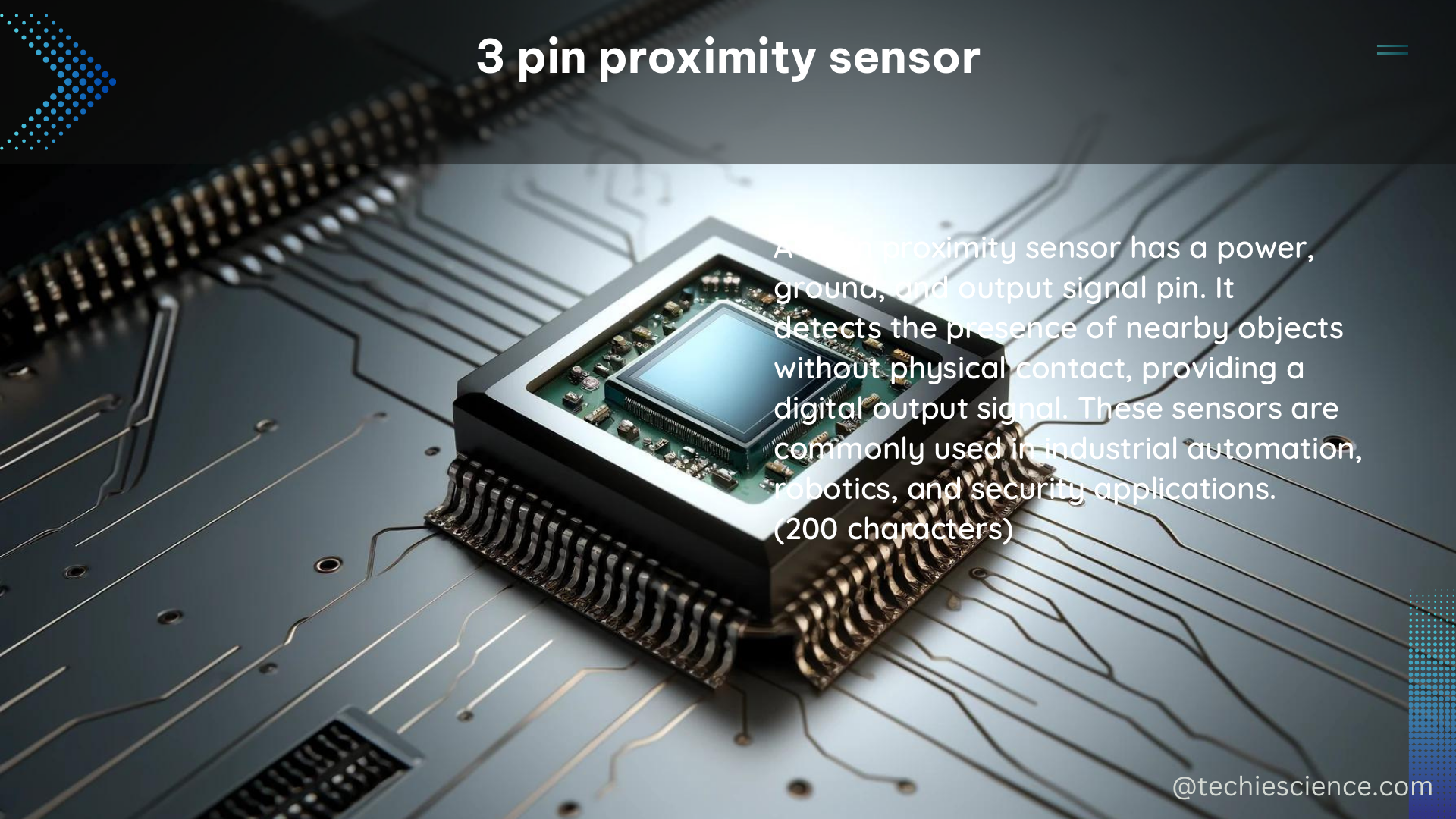A 3-pin proximity sensor is a versatile and widely used device in various industrial and automation applications. It typically consists of an NPN or PNP output transistor, an oscillator circuit, and a sensing coil. The sensor operates by generating an electromagnetic field with the oscillator circuit, which is then picked up by the sensing coil when a conductive object enters the field. This interaction causes a change in the oscillator frequency, which is then amplified and processed by the output transistor to produce a digital signal.
Understanding the Anatomy of a 3-Pin Proximity Sensor
A 3-pin proximity sensor is composed of the following key components:
-
Output Transistor: The sensor utilizes either an NPN or PNP output transistor to amplify and process the signal generated by the oscillator circuit. The choice between NPN and PNP depends on the specific application and the desired logic level output.
-
Oscillator Circuit: The oscillator circuit generates a high-frequency electromagnetic field, typically in the range of 100 kHz to 1 MHz. This field is used to detect the presence of conductive objects within the sensor’s sensing range.
-
Sensing Coil: The sensing coil is responsible for picking up the changes in the electromagnetic field caused by the presence of a conductive object. When an object enters the field, it alters the oscillator frequency, which is then detected and processed by the output transistor.
Technical Specifications of 3-Pin Proximity Sensors

The technical specifications of a 3-pin proximity sensor can vary depending on the manufacturer and model, but some common specifications include:
| Specification | Typical Range |
|---|---|
| Operating Voltage | 10 – 30 VDC |
| Maximum Current Draw | 150 mA |
| Sensing Distance | 1 – 15 mm |
| Response Time | 0.5 – 5 ms |
| Repeatability | ± 0.1 mm |
| Operating Temperature | -25°C to 70°C |
| Protection Rating | IP67 |
It’s important to note that these specifications can be further customized or optimized for specific applications, such as high-speed detection, long-range sensing, or harsh environmental conditions.
Adjusting the Sensing Distance
Many 3-pin proximity sensors come equipped with a potentiometer or other adjustment mechanism to fine-tune the sensing distance. This allows users to precisely control the detection range based on their specific requirements. The adjustment process typically involves the following steps:
- Identify the adjustment mechanism, which may be a small potentiometer or a multi-turn screw.
- Use a small screwdriver or tool to carefully rotate the adjustment mechanism.
- Observe the changes in the sensor’s output signal or the detection range using a multimeter or oscilloscope.
- Continue adjusting until the desired sensing distance is achieved.
It’s important to note that the sensing distance can be affected by factors such as the size and material of the target object, the sensor’s orientation, and the presence of nearby conductive materials. Careful adjustment and testing are recommended to ensure optimal performance.
Connecting a 3-Pin Proximity Sensor to a Microcontroller
One common application of a 3-pin proximity sensor is to integrate it with a microcontroller or other digital input device. The process of connecting a 3-pin proximity sensor to a microcontroller typically involves the following steps:
- Identify the three pins on the sensor: power (VCC), ground (GND), and output (OUT).
- Connect the power pin to a suitable voltage source, typically 10-30 VDC, on the microcontroller.
- Connect the ground pin to the ground (GND) of the microcontroller.
- Connect the output pin to a digital input pin on the microcontroller.
- Configure the microcontroller’s firmware to read the digital signal from the sensor and use it to trigger an action or event.
By integrating a 3-pin proximity sensor with a microcontroller, you can create a wide range of applications, such as object detection, position monitoring, or automated control systems.
Measuring and Analyzing 3-Pin Proximity Sensor Data
To quantify the performance of a 3-pin proximity sensor, you can measure and analyze various data points, including:
- Output Signal: Measure the sensor’s output signal in volts or milliamps to determine the logic level and the strength of the signal.
- Sensing Distance: Measure the distance at which the sensor can reliably detect the presence of a conductive object, typically in millimeters or inches.
- Response Time: Measure the time it takes for the sensor to respond to the presence or absence of a conductive object, typically in milliseconds.
- Repeatability: Measure the consistency of the sensor’s detection over multiple trials, typically expressed as a percentage or in millimeters.
- Temperature Stability: Measure the sensor’s performance across a range of operating temperatures to ensure reliable operation in different environments.
By collecting and analyzing this data, you can optimize the sensor’s configuration, troubleshoot any issues, and ensure that it meets the requirements of your specific application.
Conclusion
The 3-pin proximity sensor is a versatile and widely used device in various industrial and automation applications. By understanding its anatomy, technical specifications, and integration with microcontrollers, you can leverage this sensor to create a wide range of innovative projects and solutions. Remember to always refer to the manufacturer’s specifications and guidelines when working with 3-pin proximity sensors to ensure optimal performance and safety.
References
- Electronics.stackexchange.com, “Wiring 3 proximity sensors in series”, 2014.
- Balluff.com, “How do I wire my 3-wire sensors?”, 2021.
- Ncbi.nlm.nih.gov, “Differential Structure of Inductive Proximity Sensor”, 2019.
- Automation.com, “Understanding Proximity Sensors”, 2020.
- Omega.com, “Proximity Sensor Basics”, 2022.

The lambdageeks.com Core SME Team is a group of experienced subject matter experts from diverse scientific and technical fields including Physics, Chemistry, Technology,Electronics & Electrical Engineering, Automotive, Mechanical Engineering. Our team collaborates to create high-quality, well-researched articles on a wide range of science and technology topics for the lambdageeks.com website.
All Our Senior SME are having more than 7 Years of experience in the respective fields . They are either Working Industry Professionals or assocaited With different Universities. Refer Our Authors Page to get to know About our Core SMEs.